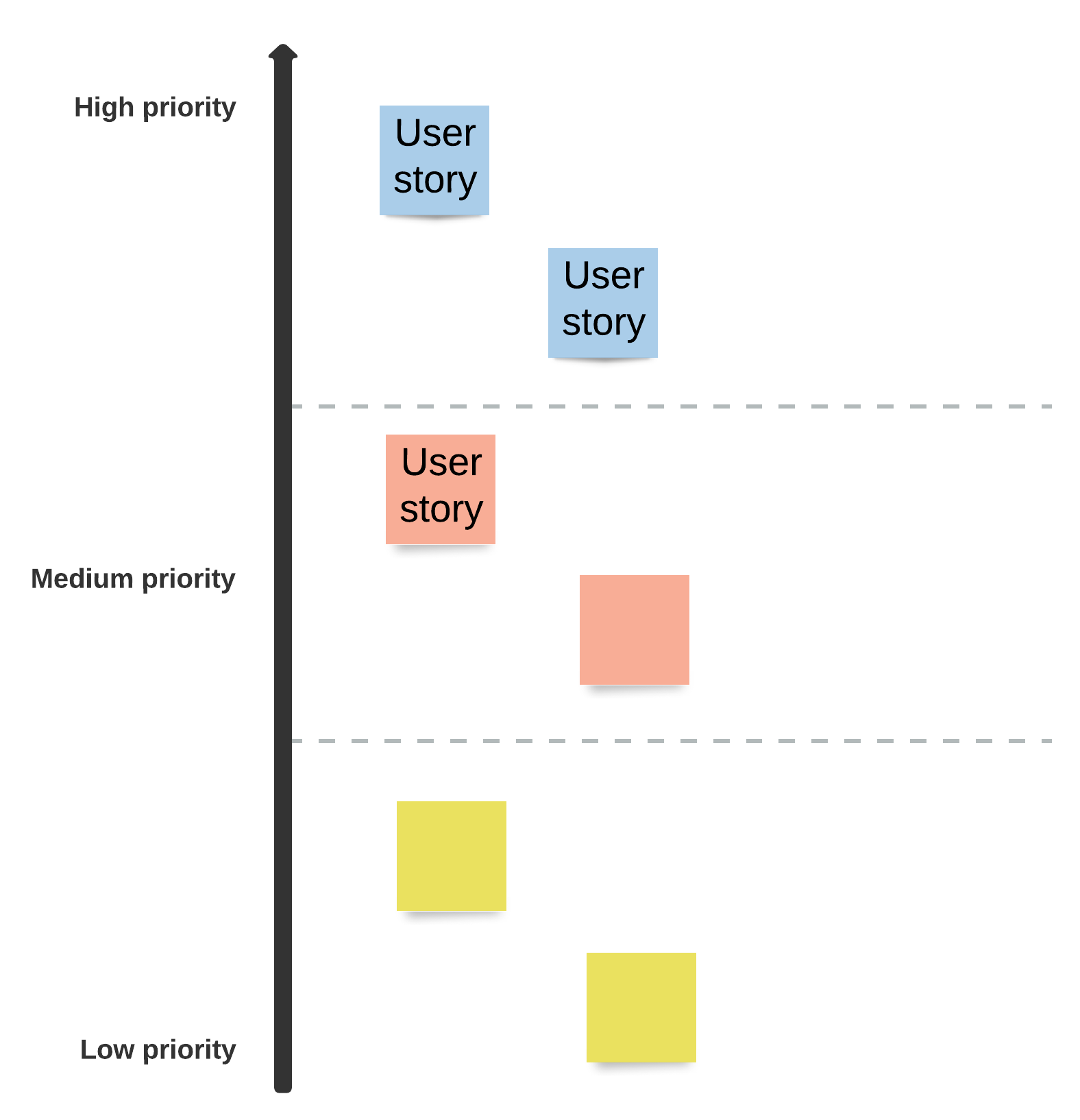
How to write sprint goals
Reading time: about 6 min
Does your sprint planning include sprint goals? Too often, sprint goals get overlooked in favor of defining and organizing the sprint backlog. But sprint goals are a crucial component of sprint plans and can help teams and stakeholders more effectively focus, prioritize, and align their work.
Discover how effective sprint goals can impact your Agile development process, increase alignment, and build buy-in at every level with these tips.
What is a sprint goal?
A sprint goal is a brief explanation of what the team plans to achieve during the course of an Agile sprint. It is a tangible goal written together by the team and Product Owner and is time-bound to the duration of the sprint.
In other words, sprint goals clarify your purpose during a program increment.
Sprint goals answer the following questions:
- What is the team working towards?
- Why is the team working to complete the sprint backlog?
- Why should stakeholders care and support the team in their efforts?
This is important because while your sprint backlog acts as your plan for the sprint, the sprint goal guides the work throughout the sprint, allowing for flexibility and re-alignment if and when new work emerges over the course of the sprint.
Example of a good sprint goal
Your sprint goals should be specific and time-bound by the sprint, while still adding value to the client. The sprint goal defines your key objective while the specific tasks and expected outcomes of the sprint should be outlined by the sprint backlog.
So what does a good sprint goal look like?
Here’s one example:
Sprint Goal: Improve customer retention by 20% by implementing a feedback system
Sprint Backlog:
- Analyze customer reviews online to identify opportunities and key pain points
- Add feedback button to 5 main landing pages
- Include pop-up customer service chat box to request feedback and provide support in real-time
- Create an automated email asking for feedback after every completed transaction
This is a good sprint goal because it clearly defines the overarching objective connecting the sprint backlog tasks. It isn’t too broad but still sets an ambitious standard for the team.
Benefits of writing sprint goals
You already have a sprint backlog mapping your sprint plans. So why do you need a sprint goal?
As noted earlier, a sprint goal further defines the purpose behind the sprint and provides guidance on future decision-making as the project evolves. If new issues or tasks emerge throughout the sprint (which is common), a sprint goal gives the team a reference for which tasks to focus on and how to organize or reprioritize different issues.
Sprint goals also:
- Provide clarity and focus on daily scrums
- Establish a benchmark for assessing progress, value, and outcomes
- Allow flexibility on the functionality implemented within the sprint
- Help the Product Owner create the product roadmap
- Guide sprint planning
- Enable efficient and aligned decision-making
How to write sprint goals
You know you need them, so how can you make sure your sprint goals are effective? Use the following tips to craft sprint goals that clarify your vision, align your work, and focus your team on the most valuable priorities.
1. Use the SMART method
You’ve heard it before but it bears repeating. Good goals follow the SMART method and sprint goals are no different.
Make sure your sprint goals are:
Specific—Get clear on exactly what you are trying to achieve, including a clear picture of what success looks like at the end.
For example, instead of saying you want to “improve site performance” define what performance you want to improve and how. For example: “Increase on-page conversion rates by 25%.”
Measurable—How will you measure progress and results? What standards will you use to define done?
This not only helps you determine when you’ve met your goals but also establishes objective benchmarks so you aren’t determining success based on any one person’s opinion.
Achievable—Your sprint goal should be ambitious but achievable. Make sure your goals are realistic based on the time and resources available.
Don’t necessarily try to fit all product backlog items into one sprint. If the goal is too big, you may need to break it down into smaller goals for separate sprints.
Relevant—How does the sprint goal connect to your business goals? Make sure your goals are relevant to your broader mission and demonstrate the value you’re trying to achieve for your business or customers.
Time-bound—Set a deadline for delivery and plan and prioritize the sprint backlog accordingly. Goals that have a clear timeline are easier to achieve and ensure everyone is working on-pace and on-target.
2. Make sure the sprint goal defines a relevant “why”
Sprint goals underline the purpose behind the sprint and direct and align your subsequent sprint backlog. But if that purpose is too broadly defined, or doesn’t have a strong connection to the work you’re doing and the value you want to deliver, it’s time to go back to the drawing board.
Your sprint goal should answer why the work matters and connect the work to the larger team and organizational mission. In other words, how does this sprint impact the business or the customers?
If your team can’t catch the vision of your sprint goal, or if the goal doesn’t feel relevant or meaningful, it can lead to a lack of focus, low motivation, and misalignment.
To keep your team engaged, productive, and excited about the work they’re doing, create sprint goals that clearly outline why the sprint is important and how the backlog of tasks connect and work together to deliver value.
3. Be open to change
The purpose of agility is that goals can change and adaptation can help improve goal setting. Use your sprint goals as guideposts for your decision-making rather than as straight jackets holding your team to a narrow set of tasks.
When new information emerges, customer needs evolve, or unexpected issues arise, refer to your sprint goals to decide how and where to move forward and be flexible to allow for optimal alignment with your key objectives and the value you’re trying to deliver.
With your new sprint goals outlined, use this guide to sprint planning to hold an effective sprint planning session.
Visualizing and tracking sprint goals
Managing a sprint backlog can sometimes feel like herding cats. There are numerous tasks, responsibilities, and people to juggle, and it’s easy for things to get lost in the shuffle. Even with a clear sprint goal guiding your efforts, it’s helpful to map out your goal and plans visually.
That’s where Lucidspark comes in. Lucidspark has templates to help you collaborate with team members and enhance the visualization of sprint goals and manage your sprint backlog.
Check out these ready-made customizable templates to get started:


Use our scrum board template and product backlog to make sprint planning easier and streamline your project management. Lucidspark’s collaborative canvas includes features like sticky notes, comments, notepads, color-coding, voting, and breakout boards so teams can work together to brainstorm, plan, and visualize their sprint goals.
Visualizing your backlog and sprint goals helps you and your team step back and get a bird’s-eye view of the work ahead and see how your tasks fit together to support your goals.

Prioritize your work for effortless sprint planning using an online whiteboard solution like Lucidspark.
Drive agility in your organizationAbout Lucidspark
Lucidspark, a cloud-based virtual whiteboard, is a core component of Lucid Software's Visual Collaboration Suite. This cutting-edge digital canvas brings teams together to brainstorm, collaborate, and consolidate collective thinking into actionable next steps—all in real time. Lucid is proud to serve top businesses around the world, including customers such as Google, GE, and NBC Universal, and 99% of the Fortune 500. Lucid partners with industry leaders, including Google, Atlassian, and Microsoft. Since its founding, Lucid has received numerous awards for its products, business, and workplace culture. For more information, visit lucidspark.com.
Related articles
Agile methodology: What it is, how it works, and why it matters
Learn how your team can deliver faster, better, stronger products through Agile methodology.
An introduction to Scrum
In this post, we’ll break down one of the most popular Agile frameworks: the Scrum methodology.
